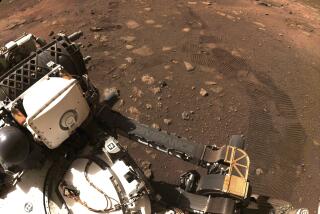A visitor’s guide to the Red Planet
You could forgive Kim Stanley Robinson for sneaking a yawn.
You could cut him some slack for being a little ho-hum, yeah-yeah, been-there, done-that about the news that humans may be headed for Mars.
You could -- but you don’t have to. Because Robinson, author of some of the most scientifically precise and emotionally profound fictional accounts of Mars ever written, is terribly excited about the prospect of manned flights to Mars, the plans for which President Bush is set to announce today. Bush’s ambitions come as Spirit rover, NASA’s robotic craft, continues to send back captivating images from the Martian surface.
“I hope it happens. I think it would be quite grand,” the 51-year-old novelist said. “The culture that would develop in stations on Mars would be interesting and heroic.”
Every bit as interesting and heroic, one hopes, as Robinson’s own depictions of what would occur during such expeditions. In his trilogy, “Red Mars” (1992), “Green Mars” (1993) and “Blue Mars” (1995), and the 1999 story collection (“The Martians”) that serves as a kind of psychodrama of his vision of inhabiting Mars, Robinson creates a grippingly plausible chronicle of how it all would work: how we’d get there and what we’d do once we arrived.
There would be fighting. And lovemaking. And politics -- cripes, imagine the politics! -- as a self-contained civilization consisting of dozens of nationalities and religions and egos created a new world amid those ancient craters. A fresh start for a species that, Lord knows, has already made a lot of mistakes in its original patch. An intergalactic Garden of Eden.
Will Mars serve as a sort of safety valve for Earth, a spillover planet to handle our population excesses? Will we remake Mars in our own image?
No wonder all manner of filmmakers and writers and TV producers flocked to the notion of a Martian odyssey, long before the Spirit rover’s snapshots or Bush’s speech. Yet unlike most fictional renditions, which are heavy on the antenna-waggling monsters and light on the science, Robinson’s works are thoroughly, painstakingly researched. His novels -- which many scientists who normally eschew the likes of “Star Wars” and “Star Trek” have named as the only fictional treatment of Martian exploration they can abide -- could serve as a blueprint for the real deal.
“His series is the best out there,” said Peter Doran, associate professor of earth and environmental sciences at the University of Illinois at Chicago.
In his novels, Robinson, who lives in Davis with his wife, an environmental chemist, and their sons, ages 14 and 8, wrote the history of Martian exploration before it occurred. Yet he’s not the least bit smug about humanity’s sudden itch to get a AAA TripTik to Mars, even though he has, in effect, already been there and back.
“If you can bulk up your scenario with a lot of true facts, you can join the normal genre of the novel,” he said. “You can make Mars as real as the world we live in now.”
In his Martian trilogy, Robinson uses the science of the Martian landscape -- its perverse geology, its odd atmospherics -- to create an utterly plausible domain. How would cities be constructed? How would vehicles be propelled? The books tell you, while illuminating the lives of his fictional pioneers.
Lacking formal training as a scientist -- Robinson earned a doctorate in English at the University of California at San Diego and wrote his dissertation on the late sci-fi author Philip K. Dick -- he studied for years before undertaking his Mars books.
Robinson joined a National Science Foundation expedition to Antarctica which, with its cold, dry conditions and abundance of dirt and rocks, is the closest approximation on Earth to a Martian landscape.
In his work, Robinson uses science as a scaffold for his narrative about the great ethical debate prompted by Mars exploration: Should Mars be turned into a second Earth -- a process called terraforming?
In “Red Mars,” the argument rages between Sax, who wants to make Mars green -- earthlike -- and Ann, who wants to keep it “red,” or in its natural state.
“Now that we are here,” Sax says, “it isn’t enough to just hide under 10 meters of soil and study the rock. That’s science, yes, and needed science too. But science is more than that. Science is part of a larger human enterprise, and that enterprise includes going to the stars, adapting to other planets, adapting them to us.... The whole meaning of the universe, its beauty, is contained in the consciousness of intelligent life.”
Ann’s reply: “We are not lords of the universe. We’re one small part of it. We may be its consciousness, but being the consciousness of the universe does not mean turning it into a mirror image of us. It means rather fitting into it as it is, and worshipping it with our attention.”
Most enthralling, Robinson said, is the actual physical presence of Mars.
In the middle of writing “Blue Mars,” he recalled, he took a small Martian meteorite he had purchased from a dealer and climbed to the roof of his home. At sunset, he popped the tiny stone into his mouth and swallowed it, hoping that having a piece of Mars inside him would enhance his creative process.
“Ordinary reality,” he said, “is a miracle at every second.”
Julia Keller is cultural critic at the Chicago Tribune, a Tribune company.
More to Read
Sign up for our Book Club newsletter
Get the latest news, events and more from the Los Angeles Times Book Club, and help us get L.A. reading and talking.
You may occasionally receive promotional content from the Los Angeles Times.








